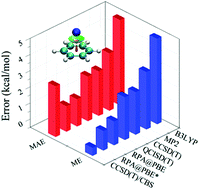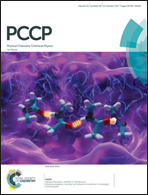An assessment of the random-phase approximation functional and characteristics analysis for noncovalent cation–π interactions†
Abstract
The binding energy is of great importance in understanding the formation and stability of noncovalent interactions. However, the determination of the binding energy with high precision and efficiency in medium- and long-range noncovalent interactions is still challenging for quantum chemistry. Here, we assess the performance of random-phase approximation (RPA), a fully non-local fifth-rung of the Jacob ladder functional, in determining the binding energy of cation–π systems (cation = Li+, Na+, Be2+, Mg2+, Al+, and NH4+; π = C6H6), which, to the best of our knowledge, has not been investigated. Using experimental results as the benchmark, we systematically compared the RPA method to the other ab initio methods (DFT/B3LYP, MP2, CCSD(T), and QCISD(T)) both in calculation accuracy and efficiency. From the perspective of accuracy, RPA is the best among these approaches, followed by the CCSD(T) and QCISD(T) methods. DFT/B3LYP and MP2 provide the worst accuracy. In addition, the computational efficiency of RPA is much faster than that of CCSD(T) and QCISD(T). We believe that RPA is a robust method for the precise description of medium- and long-range noncovalent interactions and is capable of providing benchmarking data. The interaction strength and interaction nature of cation–π systems are further analyzed by atoms in molecules (AIM) and the color-mapped reduced density gradient (RDG) isosurface, which are consistent with the characteristics of a typical cation–π interaction.



 Please wait while we load your content...
Please wait while we load your content...